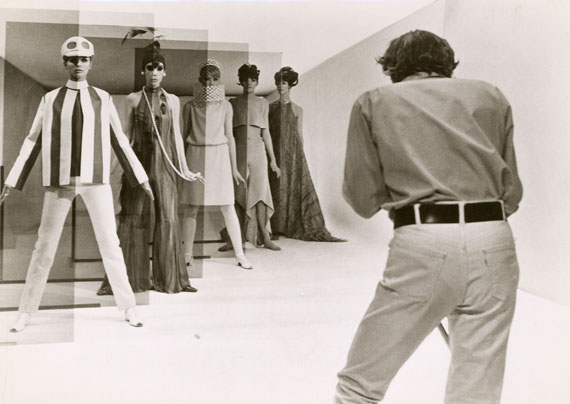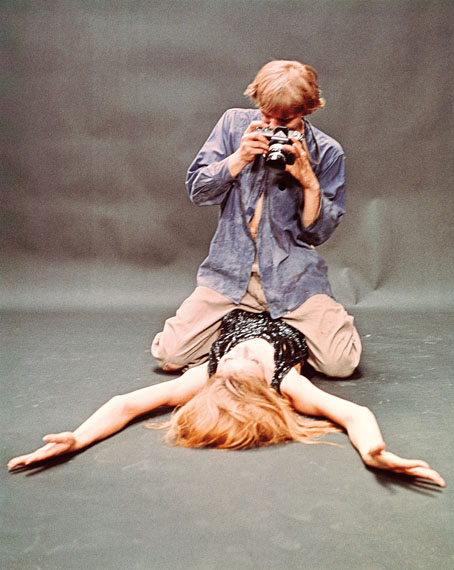
David Hemmings in Blow-Up, 1966
Film still, Ektachrome, 12.7 x 10.2 cm
BFI National Archive
Foto: Arthur Evans, Privatsammlung Wien, Courtesy: Neue Visionen Filmverleih GmbH
Blow-Up
Antonioni's Film Classic and Photography / Antonionis Filmklassiker und die Fotografie
David Bailey » Terence Donovan » Brian Duffy » Arthur Evans » Richard Hamilton » Don McCullin » David Montgomery » Tazio Secchiaroli » Ian Stephenson » Eric Swayne » & others
Exhibition: 13 Sep – 30 Nov 2014
Fri 12 Sep 18:00 - 21:00

Fotomuseum Winterthur
Grüzenstr. 44+45
8400 Winterthur
+41 (0)52-2341060
info@fotomuseum.ch
www.fotomuseum.ch
Tue, Thu, Fri 11-17; Wed 11-20; Sat-Sun 11-18

Brian Epstein (Box of Pin-Ups), 1965
Print, 61 x 50,8 cm
"Blow-Up –
Antonionís Film Classic and Photography"
Exhibition: 13 September – 30 November 2014
Opening: September 12, 6 - 9pm
The cult film "Blow-Up" by Michelangelo Antonioni (1966) occupies a central position in the history of film as well as that of art and photography. No other film has shown and sounded out the diverse areas of photography in such a differentiated way. The photographic range of ’Blow-Up’ is highly diversified and ranges from fashion photography and social reportage to abstract photography. Film stills are shown next to works that can actually be seen in ‘Blow-Up’, as well as pictures by David Bailey, Terence Donovan, Richard Hamilton, Don Mc Cullin and Ian Stepherson, that illuminate the cultural and artistic frame of the film production, London in the Swinging Sixties. For the first time in Switzerland the exhibition at the Fotomuseum Winterthur presents in several chapters the diverse and differentiated connections between film and photography, thus allowing a trenchant profile of the photographic trends of the 1960s.
Set against the social and artistic backdrop of London’s Swinging Sixties, Blow-Up tells us about a fashion photographer by the name of Thomas (David Hemmings) who secretly photographs two lovers in a park.He later enlarges these pictures and believes that he has coincidentally documented a murder. The blow-ups reveal a man lurking in the trees with a gun and, as Thomas supposes, a corpse.
However, the blow-ups only offer ambivalent proof as they become more and more blurred and abstract by the continuous enlarging. Even photography that supposedly represents reality like no other form of media cannot help in shedding any light on the mysterious events in the park. Pictorial reality – thus Antonioni’s conclusion – is only ever constructed by the medium itself.
The meaning of photography for the film ‘Blow-Up’ is most apparent when Antonioni uses it to characterise his main character Thomas. Played by David Hemmings, Arthur Evans David Hemmings in Blow-Up, 1966 the protagonist is not only a fashion photographer, but is also working on an illustrated book with photographs of social reportage. In order to depict both the main figure and its two areas of work in an authentic way, Antonioni is guided by real photographers of the time; before starting to shoot the film he meticulously researched the work as well as environment of the British fashion (photography) scene. In the course of his preparations Antonioni sent out questionnaires to fashion photographers and visited them in their studios. Thus the main character is modelled after various photographers like David Bailey, John Cowan and Don McCullin; some of them Antonioni asked to cooperate on his film. He also integrated their works, for example Don McCullin’s reportage photographs that the protagonist browses through in the film, or fashion photographs by John Cowan that in the film can be seen in the protagonist’s studio.
The show not only explores the photohistorical circumstances under which Blow-Up was made but also presents “real” works of art Antonioni integrated into his film, as well as photographs he commissioned for the story. The visual translation of the film into stills constitutes another important field thematized in the exhibition.
A cooperation between Albertina, Vienna, and Fotomuseum Winterthur.
Program: film and photography
In cooperation with the Fotomuseum Winterthur, the Filmfoyer Winterthur is showing Antonioni’s work on 35mm film, presenting five additional film classics as part of its September program “The Voyeuristic Gaze.” For a detailed program please see: www.filmfoyer.ch�

David Hemmings and Veruschka von Lehndorff in Blow-Up, 1966
Film still, Ektachrome, 12.7 x 10.2 cm
"Blow-Up – Antonionis Filmklassiker und die Fotografie"
Ausstellung: 13. September bis 30. November 2014
Eröffnung: 12. September, 18-21 Uhr
Von Michelangelo Antonioni 1966 realisiert, nimmt Blow-Up nicht nur in der Film-, sondern auch in der Fotogeschichte eine einzigartige Stellung ein. Kaum ein anderer Spielfilm hat jemals so differenziert die vielfältigen Bereiche der Fotografie gezeigt und auf so ausführliche und zeitlose Weise zu ergründen versucht. Das fotografische Spektrum ist entsprechend breit gefächert und reicht von der Modefotografie über die Sozialreportage und Pop-Art bis hin zur abstrakten Fotografie. Die Ausstellung Blow-Up zeigt diese vielseitigen Themen in fünf grossen Kapiteln und stellt durch filmische Sequenzen inhaltliche Bezüge zu Antonionis Meisterwerk her. Neben Film Stills, die dem Kinobesucher die Handlung in wenigen fotografischen Bildern erzählen, werden sowohl Werke präsentiert, die tatsächlich in Blow-Up zu sehen sind, als auch Bilder von David Bailey, Terence Donovan, Richard Hamilton, Don McCullin und Ian Stephenson gezeigt, die das vibrierende London der Swinging Sixties ins Rampenlicht stellen.
Erstmals in der Schweiz werden die berühmten Fotos zu sehen sein, die der Hauptdarsteller in Antonionis Geschichte heimlich in einem Park von einem Liebespaar aufnimmt. Der Protagonist glaubt, mit diesen Aufnahmen zufällig einen Mord dokumentiert zu haben. Die Bilder erweisen sich jedoch als ambivalente Beweise, denn auch Vergrösserungen – Blow-Ups – zeigen kein klares Bild der vermeintlichen Leiche. Dieser filmische Abriss über die Repräsentation von Bildern und deren Mehrdeutigkeit ist seither künstlerische Basis vieler zeitgenössischer FotografInnen. Antonionis Filmklassiker bleibt seit seiner Entstehung 1966 weiterhin rätselhaft und hat auch heute nicht an Relevanz verloren.
Die Ausstellung kontextualisiert aber auch Antonionis besondere Beziehung zur Fotografie. Diese tritt in der Charakterisierung seiner Hauptfigur Thomas am deutlichsten hervor. Nicht nur ist der von David Hemmings verkörperte Protagonist ein Modefotograf, sondern er arbeitet auch an einem Bildband mit Sozialreportagefotografien. Um sowohl die Figur als auch die beiden Arbeitsfelder von Thomas authentisch zu schildern, orientierte sich Antonioni an realen britischen Fotografen der Zeit, deren Tätigkeit und Umfeld der britischen Mode(foto)szene er vor den Dreharbeiten minutiös recherchiert hatte. Antonioni schickte im Zuge seiner Vorbereitungen Fragebögen an Modefotografen und besuchte sie in ihren Studios. Daraufhin lud er einige von ihnen ein, aktiv am Film mitzuwirken.
Die Ausstellung Blow-Up präsentiert die Originalwerke, welche Antonioni inspiriert hatten oder gar zu einem Bestandteil seines Spielfilms wurden: etwa Don McCullins Reportagefotos, die der Protagonist an einer Stelle des Filmes durchblättert, und Modefotos von John Cowan, die im Fotostudio zu sehen sind. Mit der Verbindung von Film, Fotografie und Film-Stills situiert sich die Ausstellung in einem zentralen visuellen Spannungsfeld.
Eine Zusammenarbeit zwischen der Albertina, Wien und dem Fotomuseum Winterthur.
Rahmenprogramm: Film und Fotografie
In Zusammenarbeit mit dem Fotomuseum Winterthur zeigt das Filmfoyer Winterthur Antonionis Werk auf 35mm-Rolle und präsentiert mit dem September-Programm «Der voyeuristische Blick» fünf weitere Filmklassiker: www.filmfoyer.ch�

David Hemmings in Blow-Up, 1966
Film still, gelatin silver print, 20.3 x 25.4 cm
Private Collection, Wien
Foto: Arthur Evans, Privatsammlung Wien, Courtesy: Neue Visionen Filmverleih GmbH

Grace and Telma, Italienische Vogue, 1966
Gelatin silver print, 51 x 61 cm
The Estate of Eric Swayne
© Eric Swayne